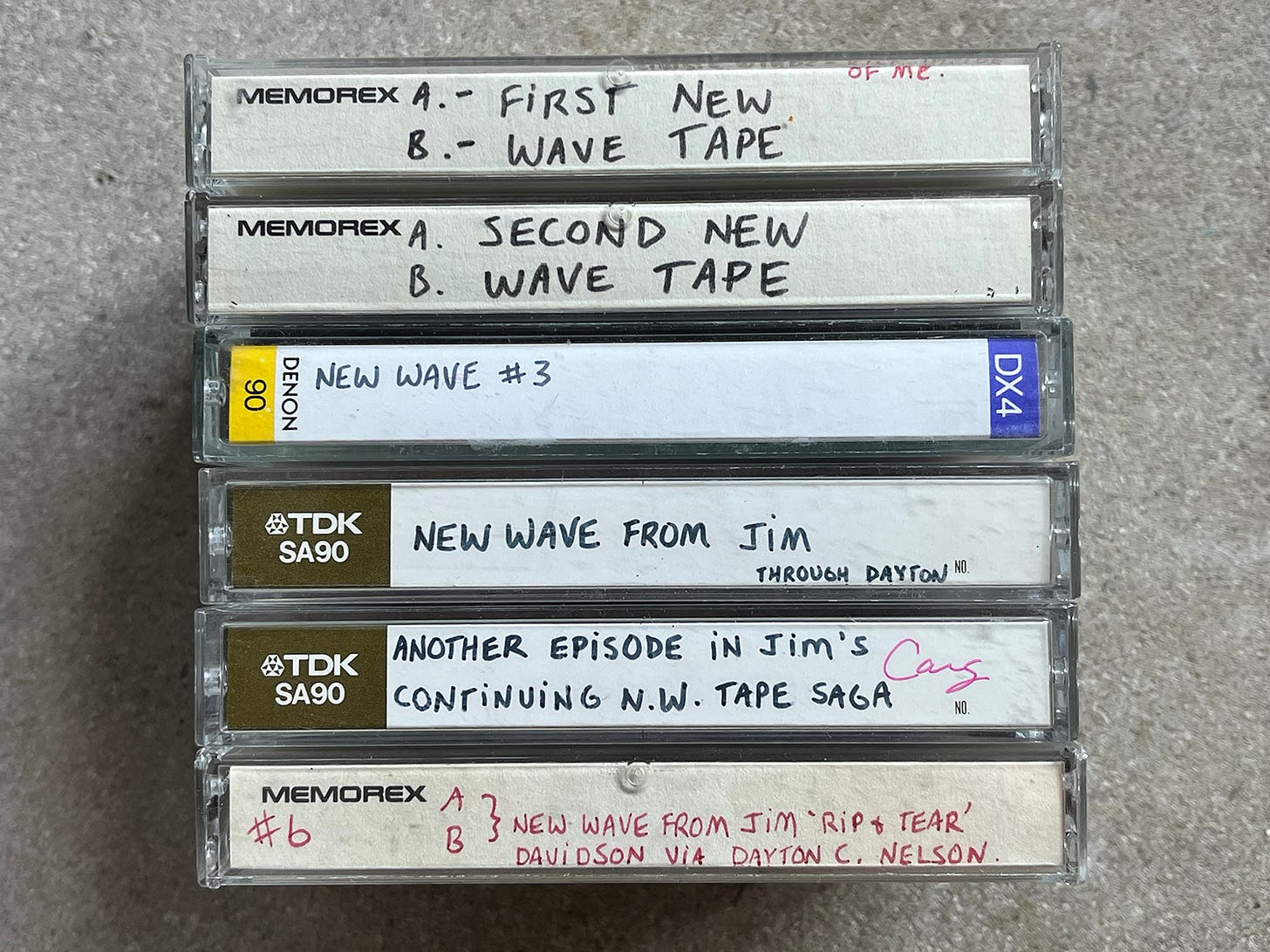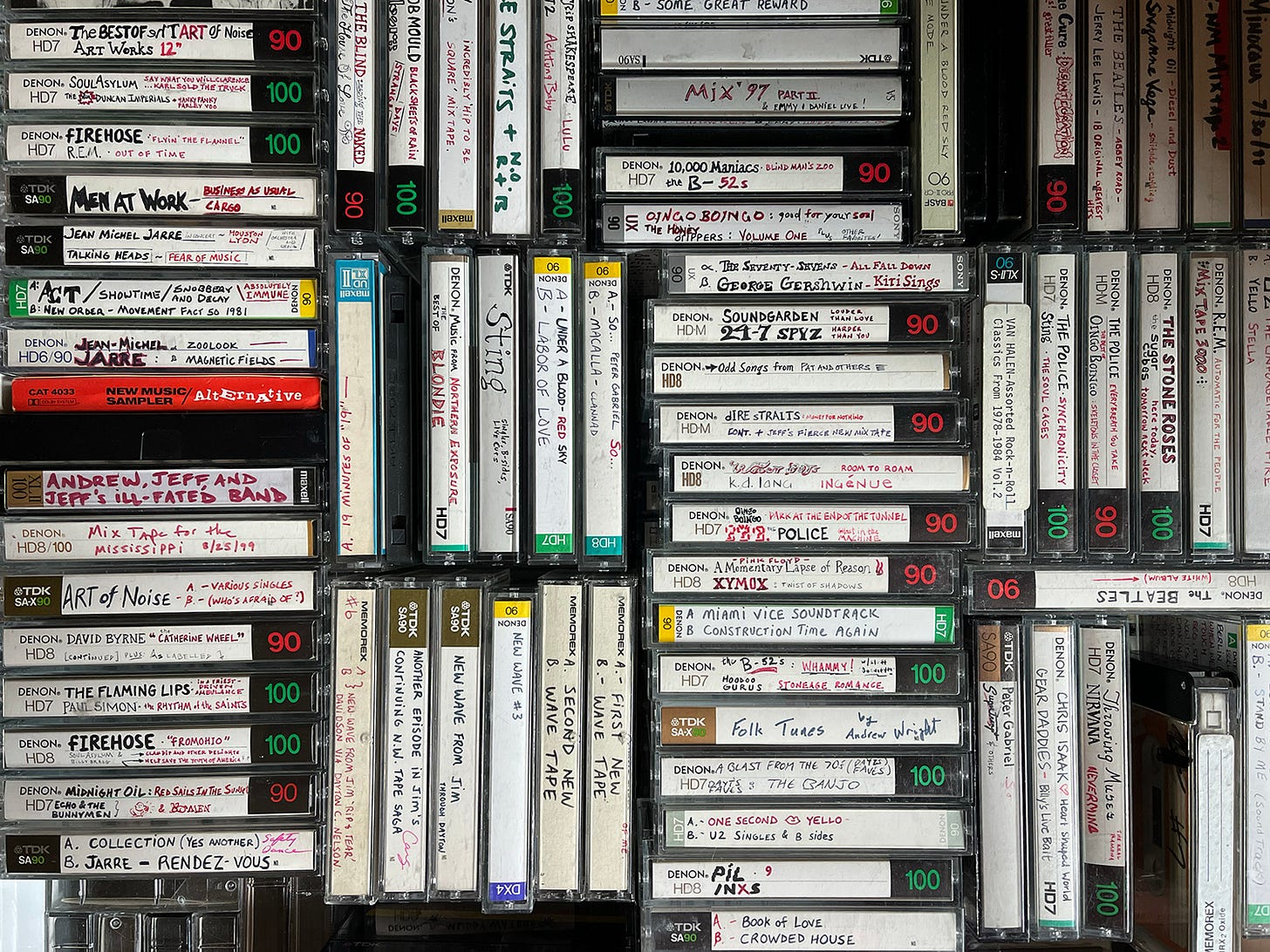Cassette tapes are back, baby! They are following in the footsteps of the vinyl resurgence of recent decades, I’ve heard it said. Cheapaudioman shares his thoughts here, in a very good overview of the entire topic.
It’s hard to believe (even for me) that the cassette tape format led music sales from 1985-1992, or so says this article. I bought quite a few prerecorded cassettes back then, as I didn’t know much about vinyl yet and didn’t have a good stereo setup. On the whole, I suppose this can be taken as a sign that people (including me) valued convenience over quality back then, just as they do today. CDs took over the lead in 1993, which was an improvement in quality over cassettes, for sure, but vinyl, which is superior to both (so it is said), was ignored for decades. Now that vinyl has been revived and is outselling CDs, are cassettes next to follow in the cycle?
Besides convenience, the main thing cassettes had going for them in the ‘80s is the control they gave to users. Mere mortals could finally make their own record albums on the cheap. In one of the first signs of the music industry shooting itself in the foot, music piracy took off with this invention, for sure, but more importantly for real people, they could put their great taste on display by making their own greatest hits collections from the music they already owned (or leave off all the lousy filler tracks from albums). And not only that, but you could easily copy your own works of creativity and give them away to fawning admirers (or in my case, girls you desperately hoped to have as fawning admirers).
As for me, I didn’t think cassette tapes were revolutionary in the 1980s — it’s just the technology that was available when I started caring about music, and I used it wholeheartedly. I copied music from records using friends’ stereo systems, and I used my own dual-cassette boombox to copy tapes (using the high-speed dub feature, ya know). From those sources, I made my own mix tapes and then copied those for others, refining my tastes as I went. Here’s part of a drawer of tapes I still have from my glory days back in the ‘80s:
The main inspiration I had for making my own mix tapes (and setting my musical tastes) was a set of tapes that came to me via my buddy Dayton. Dayton lived a cosmopolitan lifestyle, traveling from Florida to Minnesota regularly, and he had a source for music in Florida called Jim “Rip & Tear” Davidson. In the ‘80s, both the east and west coasts of the USA dictated pop culture to flyover country, and to get ahold of exotic new sounds in a time of Top 40 dominance was revelatory.
Over time, six of these “new wave” mix tapes came to me via Dayton from Jim in Florida, and they became legendary to all involved. As far as I know, they were taped from radio stations in Florida, which were far more cutting-edge compared to what I could hear in outstate Minnesota. I listened to local rock stations, and also faraway stations like WRNO on my Sony ICF-2002 via shortwave (my dad was a ham radio guy), but I hadn’t heard this crazy new wave stuff anywhere, or identified it as such.
“New Wave” is a pretty loose term, meaning different things to different people. It could mean anything that came after punk, or it could mean everything that wasn’t really mainstream from 1978-1988. To me, it primarily meant semi-obscure, primarily British bands whose music could mostly be bought in offbeat music stores as expensive imported vinyl. In Rochester, MN, a good music store meant Face the Music at Crossroads shopping center, while in Minneapolis this meant Northern Lights on Hennepin Ave in the seedy, dangerous downtown area in the Purple Rain era. (Sam Goody and Musicland were mainstream mall stores and didn’t have much of the good stuff.)
It’s hard to say why new wave struck me better than any other sort of music available at the time. Certainly I’ve looked around and listened to music extensively in the years since and found plenty of pre-1985 music of all genres to enjoy, but I think at the time I just wanted something different, and my circle of friends and I liked what we heard from new wave enough to make it ours. In most ways it may be arbitrary what type of music you like, as long as your friends like it too, and finding an identity (both individual and shared) via this music of the time helped me to be cooler in my own mind than was the stereotypical Michael Jackson fan. Looking back, it is hard to express how important this identity was to me and my group of early teenaged friends. It was as foundational as religion or ancestry, and far more important for a certain timeframe.
Younger people than me must understand that today’s world of easy online information access conceals how hard it was to know anything about bands and music in the early ‘80s. There was nothing online available (to normal people), except prehistoric-seeming dial-up BBSs which were mostly local, due to expensive long-distance charges. I suppose older and wiser people than me subscribed to the right magazines, went to nightclubs, and had more context in the music world, but I was just a kid, trying to figure out what I liked, playing games on my Commodore 64, and listening to American Top 40 with good old Casey Kasem. There was a dearth of alternative cultural information available at the time, it is safe to say, and this is what forced me (and many others) to sit and listen to the Top 40 every week for hours to learn anything at all. I had no idea how many different worlds of music even existed, much less how to become part of them.
(As an aside, I do recall that Top 40 in the early ‘80s was much more interesting than what passes for mainstream music today, but that could be old guy thinking. Get off my lawn!)
Despite plenty of halfway-decent mainstream music, kids’ minds search for innovation and move quickly, however, and the desire to differentiate oneself and learn more and more takes over (for some, anyway). In the ‘80s, I grasped onto what I could, and I suppose the same is true today — many younger people are content with Taylor Swift, Benson Boone, or Sabrina Carpenter, while other weirdos want to know more about The Garden, Death Grips, or Black Midi (and endless numbers of other bands from outside the mainstream music machine). I was one of those weirdos back in the ‘80s who wanted more than Kenny Loggins, Phil Collins, or Michael Jackson had to offer. Few kids want to listen to the same music their parents do.
On an oddly related note, there is now a recently released streaming series called Mix Tape, presumably attempting to surf the wave of cassette tape nostalgia and revival. I have begun watching the show, and it’s more about breaking up with a current, unhappy, one-dimensional placeholder partner to return to one’s true love from high school than mix tapes, despite the title. Mix tapes and love of music figure into the story, and are shown being created and discussed, in arguably awkward ways, but they are a subordinate part of the show. I recall back in the day, that as inordinately important as music was to me, other aspects of relationships very quickly surpassed a mutual love of The Cure in priority. Mix tapes established a beachhead from where a romantic military invasion could be launched but it was not enough to form and maintain a coupling more serious than a make-out partner or prom date, which in hindsight, was perfectly acceptable at that time. Maybe this topic is not really a new thing, as a Netflix movie called Mixtape was made in 2021, and I suppose the movie king for and about music-obsessed people is High Fidelity. But I digress.
After all this setup, I suppose it is time to talk about what is on these mythical new wave tapes, and here’s Tape 1.



